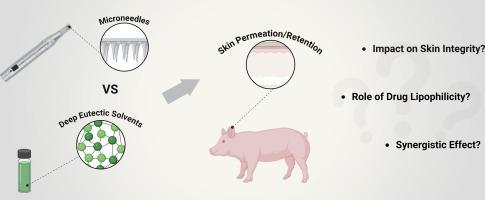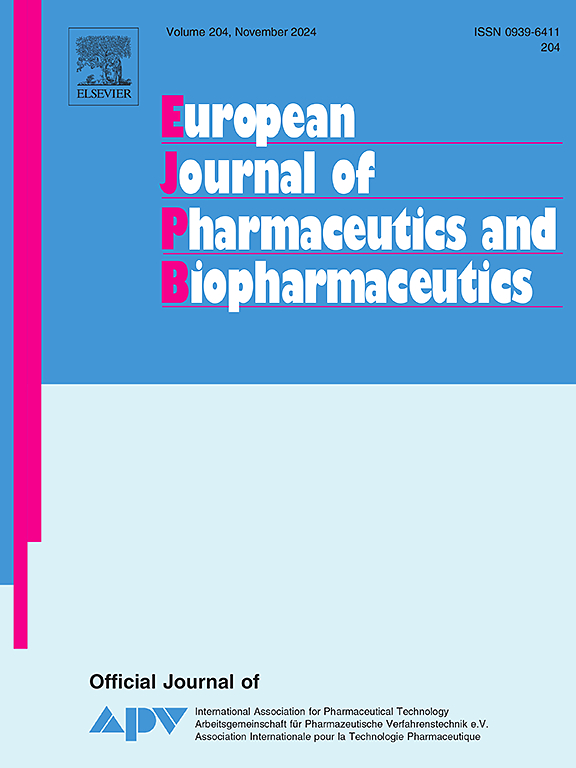Comparing effects of terpene-based deep eutectic solvent and solid microneedles on skin permeation of drugs with varying lipophilicity
IF 4.4
2区 医学
Q1 PHARMACOLOGY & PHARMACY
European Journal of Pharmaceutics and Biopharmaceutics
Pub Date : 2024-11-09
DOI:10.1016/j.ejpb.2024.114576
引用次数: 0
Abstract
Transdermal delivery of therapeutic molecules is often hindered by the properties of the skin, with the stratum corneum serving as the primary permeation barrier. To overcome this barrier, the integrity of the stratum corneum can be modified by chemical permeation enhancers, such as deep eutectic solvents (DESs), or by mechanically impairing the skin with microneedles (MNs). However, a systematic comparison between these strategies is currently lacking. Hence, this study examined the potential of DESs and MNs to promote the permeation and retention of drugs with varying lipophilicities – specifically, the hydrophilic drug metronidazole (logP ∼ 0), the moderately lipophilic drug lidocaine (logP ∼ 2.3), and the highly lipophilic drug clotrimazole (logP ∼ 5). A mixture of menthol and thymol was selected as a model terpene-based DES and delivery vehicle, while a DermaPen equipped with solid MNs was used to mechanically impair the skin. Permeation rates of model drugs applied to the skin with either DES, MNs, or both were compared to the rates determined for the drugs applied in control vehicles. Both strategies were found to compromise the skin barrier function, but their permeation-enhancing effect was dependent on the lipophilicity of tested model drug. The DES was most effective for the hydrophilic drug metronidazole, while the MNs were more effective in increasing the permeation of the highly lipophilic drug clotrimazole. For the moderately lipophilic drug lidocaine, neither the DES nor MNs increased its permeation rate, as the drug permeated through the skin well on its own. Notably, the combination of both enhancement strategies did not result in significantly better permeation rates of the drugs compared to the individual approaches. In conclusion, both the terpene-based DES and solid MNs are effective strategies to enhance drug permeation through the skin, but our results suggest that the choice of strategy should be dictated by the drug’s lipophilicity. Moreover, from a permeation-enhancing perspective, there is no benefit in combining these two strategies.

比较萜烯基深共晶溶剂和固体微针对不同亲脂性药物皮肤渗透的影响
治疗分子的透皮给药通常受到皮肤特性的阻碍,而角质层是主要的渗透屏障。为了克服这一障碍,可以通过化学渗透促进剂(如深共晶溶剂(DES))或微针(MN)机械损伤皮肤来改变角质层的完整性。然而,目前还缺乏对这些策略的系统比较。因此,本研究考察了 DESs 和 MNs 促进不同亲脂性药物渗透和保留的潜力,特别是亲水性药物甲硝唑(logP ∼ 0)、中等亲脂性药物利多卡因(logP ∼ 2.3)和高亲脂性药物克霉唑(logP ∼ 5)。薄荷醇和百里酚的混合物被选为基于萜烯的 DES 和输送载体模型,而装有固体 MNs 的 DermaPen 则用于机械损伤皮肤。将使用 DES、MNs 或两者的皮肤模型药物渗透率与使用对照载体的药物渗透率进行了比较。结果发现,这两种方法都会损害皮肤屏障功能,但它们的渗透增强效果取决于被测模型药物的亲脂性。DES 对亲水性药物甲硝唑最有效,而 MN 对增加高亲脂性药物克霉唑的渗透更有效。对于中等亲脂性药物利多卡因,DES 和微针都不能提高其渗透率,因为这种药物本身就能很好地透过皮肤。值得注意的是,与单独使用两种方法相比,两种增强策略的结合并没有明显提高药物的渗透率。总之,基于萜烯的 DES 和固体 MNs 都是增强药物在皮肤中渗透的有效策略,但我们的研究结果表明,策略的选择应取决于药物的亲脂性。此外,从促进渗透的角度来看,将这两种策略结合使用并无益处。
本文章由计算机程序翻译,如有差异,请以英文原文为准。
求助全文
约1分钟内获得全文
求助全文
来源期刊
CiteScore
8.80
自引率
4.10%
发文量
211
审稿时长
36 days
期刊介绍:
The European Journal of Pharmaceutics and Biopharmaceutics provides a medium for the publication of novel, innovative and hypothesis-driven research from the areas of Pharmaceutics and Biopharmaceutics.
Topics covered include for example:
Design and development of drug delivery systems for pharmaceuticals and biopharmaceuticals (small molecules, proteins, nucleic acids)
Aspects of manufacturing process design
Biomedical aspects of drug product design
Strategies and formulations for controlled drug transport across biological barriers
Physicochemical aspects of drug product development
Novel excipients for drug product design
Drug delivery and controlled release systems for systemic and local applications
Nanomaterials for therapeutic and diagnostic purposes
Advanced therapy medicinal products
Medical devices supporting a distinct pharmacological effect.

 求助内容:
求助内容: 应助结果提醒方式:
应助结果提醒方式:


